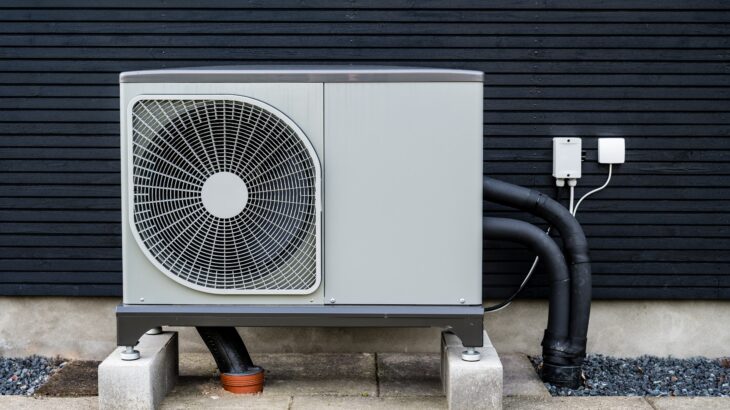
If you’re in search of an energy-efficient way to keep your building at an ideal temperature no matter the season, consider switching to heat pumps. Maintaining heat on cold winter days and bringing cool air to humid summer ones is critical for a New Hampshire home or business. Heat pumps can provide a long-lasting solution for the ever-changing seasons to come.
The principle is simple but the effects are anything but; moving heat rather than generating it not only optimizes your home or facility’s heating and cooling operations—it slashes greenhouse gas emissions, too.
What are Heat Pumps?
Let’s break down how heat pumps work. There are a few main types of units to consider depending on your building’s needs.
- Air Source Heat Pumps (ASHPs): In the wintertime, air source heat pumps operate by using refrigerants to absorb outdoor heat and then pressurize it, releasing warm air into your building for a highly efficient heating system. In the summertime, this process is reversed; refrigerants from the indoor unit absorb warm air and direct it outdoors for further air conditioning exchanges. ASHPs are versatile and many subtypes are on the market depending on your needs. The most common is the ducted ASHP, which operates by hooking up to your building’s existing forced-air system. Ductless ASHPs and minisplits are available for buildings without existing ductwork and are most common in homes and facilities that previously relied on radiator heating. These systems rely on installing individual air vents mounted inside your space that connect to a condenser.
- Heat Pump Rooftop Units (HP RTUs): For commercial applications of energy efficient heating and cooling, heat pump rooftop units are the most common choice. HP RTUs come in three main types (dual fuel, all-electric, and cold climate) to best match your commercial building’s needs regarding ventilation, human comfort, schedules, load, and more. The Better Buildings Solutions Center notes that dual fuel heat pumps work with fossil fuel-fired furnaces, all-electric heat pumps pairing with resistance heating when needed, and cold climate heat pumps providing heat for buildings in very low temperatures.
- Geothermal Heat Pumps (GHPs): Geothermal heat pumps capitalize on the temperature of the earth. The U.S. Department of Energy explains that GHPs “act as a heat sink—absorbing excess heat during summer, when surface temperatures are relatively higher—and as a heat source during the winter, when surface temperatures are lower.” GHPs rely on ground temperatures as opposed to air temperatures which can be variable depending on your location.
Heat Pump Benefits
The advantages are hard to ignore: because heat pumps can produce up to three times more energy than they consume, the potential for significant cost savings over time is undeniably high. Improved air quality and quieter workspaces are also up for grabs due to how heat pumps filter and circulate air and operate at just 42 decibels (for comparison, a library generally sits at 40 decibels). In commercial facilities, upgrading to these energy-savers can mean long-term “soft” benefits for your employees and visitors as well as substantial cost savings. Paired with the ability to easily control your space’s temperature, these benefits not only help you live and work in a more comfortable environment—they support the global environment’s health as well. Notably, a 2021 UC Davis study found that residential heat pumps can reduce carbon dioxide emissions by up to 75% compared to gas furnaces. For large commercial applications, achieving sustainability goals by decarbonizing a building’s footprint is within reach with a swap to energy-efficient heat pump rooftop units. And by reducing fossil fuel consumption and limiting carbon emissions, the earth takes a well-earned break.
Which Model is Right for Me?
Finding the right heat pump model for your residential needs is dependent on a few variables: climate, load and sizing, and distribution. Identifying your climate zone is a great first step, as this will address the question of humidity levels in your neck of the woods. A trusted contractor can help you understand your load levels and therefore narrow down your model options. The final step is the knowledge of whether you need a ducted or ductless system to find the right type of heat pump for your building. In commercial settings, investigate your building’s needs with these same considerations and connect with a local contractor to identify which type of HP RTU is right for your commercial property.
Getting Started
To get started, reach out to your local utility provider for a home or facility assessment; this will provide you with custom weatherization or energy efficient improvement recommendations that are unique to your building’s needs. These improvements can help to both determine the size and type of heat pump that best suits your space and maximize the efficiency of your heat pump system. Following this, a qualified contractor can facilitate an energy audit of your building and identify the next steps on your journey to energy-efficient heating and cooling.
If you’re considering a heat pump installation for your home or business, look to the NHSaves® utility partners to discover available residential rebates and commercial incentives. With financing options for your building no matter the type or scale, a suite of benefits and energy and cost savings are just around the corner.
Eversource, Liberty and Unitil Electric Customers
| Equipment | Minimum Requirements | Rebate Amount | |
| Air-Source Heat Pump | Ducted | Refer to NHSaves.com/HPQPL | $250 per ton* |
| Ductless | |||
| Air-Source Heat Pump Replacing Electric Resistance | Ducted | Pre-Verification Required NHSaves.com/GetVerified; Refer to NHSaves.com/HPQPL | $1,250 per ton* |
| Ductless | |||
| Central Air Conditioner | – | ENERGY STAR certified | $70 per ton* |
| Wi-Fi Thermostat** | – | Must be installed with a qualified heat pump system | $85 per unit |
| *Rebate based on tonnage calculated by dividing AHRI cooling capacity by 12,000 (e.g., 40,000 Btus cooling/12,000 = 3.33 tons. 3.33 tons x $/ton = rebate). Limit 5 tons (5) per account. Customers who heat primarily with a working, permanent electric resistance heat and are installing qualified heat pumps may be eligible for up to $1,000 per ton in addition to the standard $250 per ton rebate. Pre-verification is required. Visit NHSaves.com/GetVerified prior to your heat pump install to pre-verify. **Wi-Fi connections must be Internet enabled. Rebate not to exceed purchase price. Limit one (1) thermostat per heat pump zone installed per account. | |||
New Hampshire Electric Cooperative Members
| Equipment | Minimum Requirements
|
Rebate Amount | |||||
| Air-Source Heat Pump | Ducted |
|
$250 per ton* | ||||
| Ductless |
|
||||||
| Air-Source Heat Pump Replacing Electric Resistance | Ducted | Pre-Verification Required NHSaves.com/GetVerified; Refer to ahridirectory.org | $1,250 per ton* | ||||
| Ductless | |||||||
| Central Air Conditioner | – |
|
$70 per ton* | ||||
| Wi-Fi Thermostat** | – | Must be installed with a qualified heat pump system | $85 per unit | ||||
| *Rebate based on tonnage calculated by dividing AHRI cooling capacity by 12,000 (e.g., 40,000 Btus cooling/12,000 = 3.33 tons. 3.33 tons x $/ton = rebate). | |||||||
| **Wi-Fi connections must be Internet enabled. Rebate not to exceed purchase price. Limit one (1) thermostat per heat pump zone installed per account. | |||||||
